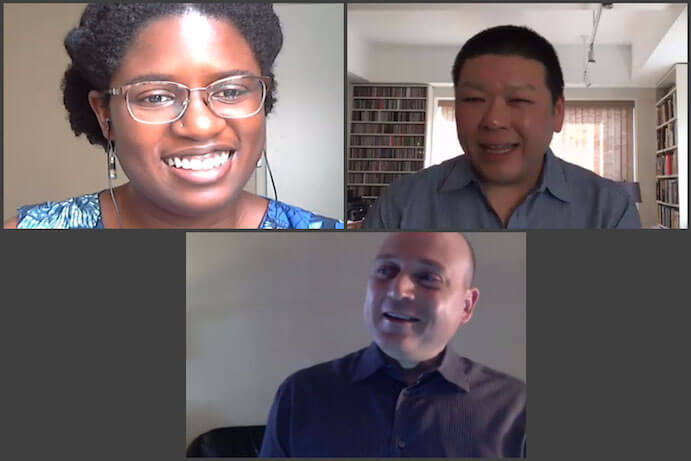Overwhelmed by the wave of livestream? As amazing as all the archives are, I’m finding myself drawn to experiences made for the moment we’re in. Simplicity and human connection is key–like “Connecting ACO Community,” part of American Composers Orchestra’s performer pandemic support, which awards each participating composer and soloist $500 and six months of streaming rights.
“Connecting ACO Community” commissions new solo works prepared for virtual interactive presentation. Composer Sakari Dixon Vanderveer’s Two Thoughts and a Fixation was the fourth in the series, and ACO Artistic Director and clarinetist Derek Bermel’s performance will live on ACO’s digital platforms, including the ongoing festival MUSIC on the REBOUND.
These days, you might have regular eyestrain headaches and feel constantly disembodied. No? Just me? But this event was only thirty-five minutes long. The length wasn’t advertised, but my initial surprise turned into relief and I became much more engaged. More than 80% of the event was human connection. The actual premiere was six minutes long, and the rest of the time, ACO President and CEO Ed Yim hosted a discussion of the composition and collaboration process. It was nice to see the composer and performer so closely; they were excited to be there, and the random details–a dog in the apartment above Derek–were humanizing. This primacy of relationships and conflicted industry expectations radiated from the Q&A. Although Dixon was told as a young composer that success arises playing a game of numbers–apply, apply, apply–everything in this streamed event was about genuine relationships. The premiere came from connections made in prior collaborations, and a discussion of Dixon’s own call for scores to composers over age 40 recognized age bias in the community.
Sakari Dixon Vanderdeer–Photo by William Vasta
In the concert hall, sound quality and production value experiences often vary depending on the affordability of a seat. This particular hierarchy is now flat–for the moment–since people have an identical experience as long as they have access to the required technology. This virtual medium also forces hospitality. Small things like performer positioning and lighting need to be considered not only as a technical challenge but as a possible barrier to connection. No longer can performers just walk out, play, bow, and leave as in some old concert pageantry. It’s a challenge to communicate effectively in this virtual concert world: without a venue, it’s hard to know your audience and how to tailor your presentation. In a live performance, you’d know the difference between a Lincoln Center and a Roulette audience.
And what about that live audience buzz before a show? By now, you’ve seen the myriad ways Zoom meetings and webinars can be utilized. Some hosts curate chat engagement well and enhance both group presence and individual belonging. ACO missed this opportunity–the chat was only utilized by a few viewers who dropped in random greetings, Q&As, or applause per the evolving etiquette. It used to be verboten to use your phone during a concert; now, we almost have to live-tweet to generate that social chatter, though it can feel weird to put thoughts out if you don’t know who you’re speaking to or who else is watching. I’ve come to expect a count of how many participants are in attendance and seeing names and at least some faces of those present; this wasn’t the case at ACO’s May 10th stream, which felt strange in a setting designed to “connect the online community.”
Derek Bermel–Photo courtesy American Composers Orchestra
The Q&A humorously revealed polar opposite interpretations of Sakari Dixon Vanderveer’s work. Derek was eager to play a new composition by Sakari, recalling her work as melodic, often tonal, and deeply thoughtful, with every note placed with exceptional care. When probed about her inspiration and process, however, Sakari revealed that improvisation plays an increasingly central role in her process, and that her most formative influence was Schoenberg’s music and writing, which freed her to consider tonality or atonality equally.
Musically, though, they agreed. Their individual instruments–viola and clarinet–are “direct competitors” with similar ranges, so Sakari could write idiomatically for the clarinet. Her three movements showed off the clarinet’s full expressive range in a good time frame: I had to adjust my headset for some fun extreme registral moments, and I felt pleasantly energized after logging off.

